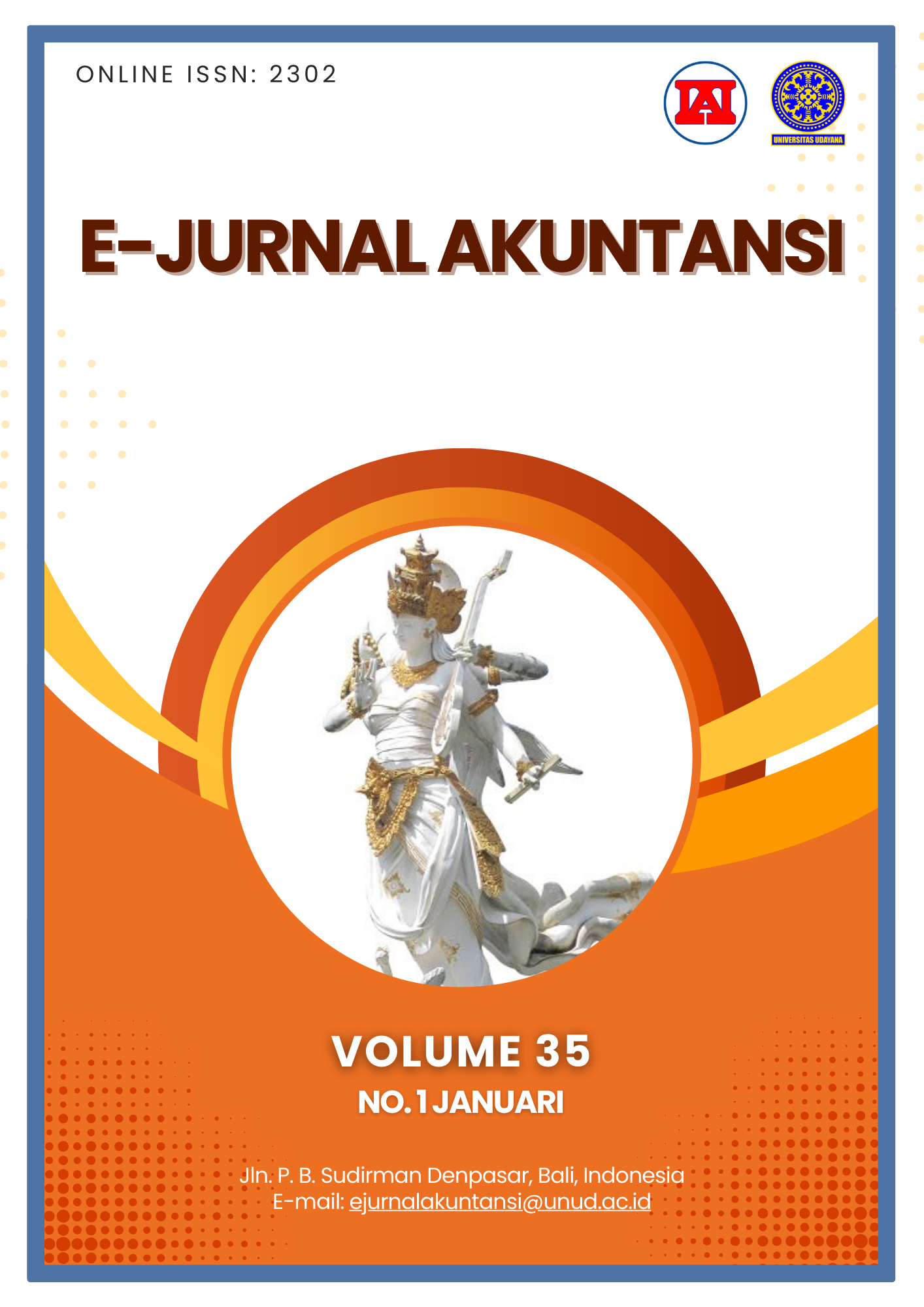Deteksi Kecurangan melalui Sistem Pengendalian Internal, Budaya Organisasi dan Etika Perilaku
Abstract
Testing the tendency to commit fraud can be seen from several factors, namely the internal control system, organizational culture and ethical behavior as well as testing the role of accounting information systems in ethical behavior against fraud. Primary data was collected through a survey of 146 respondents given to employees of the Semarang Commissariat Bank Perkreditan Rakyat. Data analysis uses multiple regression path analysis using WarpPLS software. The research results reveal that internal control, organizational culture and ethical behavior have a significant negative effect on the tendency to commit fraud. These results indicate that there is a partial mediation effect on the ethical behavior variable. However, the effectiveness of the accounting information system does not have a moderating effect on ethical behavior on the tendency to commit fraud. This is due to pressure, opportunity and rationalization from employees themselves which can influence the tendency to commit fraud.
Keywords: Organizational culture; Ethical Behavior; Internal Control System; Accounting information system; Fraud.
Downloads
References
Abd Rahim, S. A., Nawawi, A., & Salin, A. S. A. P. (2017). Internal control weaknesses in a cooperative body: Malaysian experience. In Int. J. Management Practice (Vol. 10, Issue 2).
Akyuwen, R., Susilo, Y. S., & Kusumawijaya, R. (2019). COMPARATIVE FINANCIAL PERFORMANCE OF REGIONAL DEVELOPMENT BANKS (BPDS) AND THE BANKING INDUSTRY IN INDONESIA. In Journal of Applied Economics in Developing Countries (Vol. 4, Issue 1).
Asmah, A. E., Atuilik, W. A., & Ofori, D. (2019). Antecedents and consequences of staff-related fraud in the Ghanaian banking industry. Journal of Financial Crime, 26(3), 669–682. https://doi.org/10.1108/JFC-08-2018-0083
Association of Certified Fraud Examiners. (2022). Diakses pada 12 Desember 2023 dari https://acfe-indonesia.or.id/
Azizah, S., & Reskino, R. (2023). Pendeteksian Fraudulent Financial Statement: Pengujian Fraud Heptagon Theory. Jurnal Akuntansi Dan Governance, 4(1), 17. https://doi.org/10.24853/jago.4.1.17-37
Badan Pusat Statistik. (2023). Diakses pada 9 Desember 2023 dari https://www.bps.go.id/id
Chapple, E., Walsh, K., & Shen, Y. (2020). Corporate Culture and Fraud. Emerald Publishing Limited, Leeds, 85–106.
Delone, W., & McLean, E. (2003). The DeLone and McLean Model of Information Systems Success: A Ten-Year Update. Ournal of Management Information Systems , 19(4), 9–30.
Feng, M., Li, C., McVay, S. E., & Skaife, H. (2015). Does ineffective internal control over financial reporting affect a firm’s operations? Evidence from firms’ inventory management. Accounting Review, 90(2), 529–557. https://doi.org/10.2308/accr-50909
Hair, J. F., Tomas, G., Hult, M., Ringle, C. M., & Sarstedt, M. (2017). A Primer on Partial Least Squares Structural Equation Modeling (PLS-SEM). https://www.researchgate.net/publication/354331182
Hartini, S., Yusuf, D., Asyraini, S., Amir Hamzah Medan, U., Pancing Pasar Barat, J. V, Estate, M., Baru, K., Sei Tuan, P., & Percut Sei Tuan, K. (2023). Management integrity, internal control, and organizational culture as accounting fraud predictors. Journal of Management Science (JMAS), 6(1), 10–14. https://doi.org/https://doi.org/10.35335/jmas.v6i1.173
Jalil, F. Y. (2018). Internal Control, Anti-Fraud Awareness, and Prevention of Fraud. Tikonomi: Jurnal Ekonomi, 17(2), 297–306. https://doi.org/https://doi.org/10.15408/etk.v17i2.7473.
Kaptein, M. (2008). Developing and testing a measure for the ethical culture of organizations: The corporate ethical virtues model. Journal of Organizational Behavior, 29(7), 923–947. https://doi.org/10.1002/job.520
Kumar, K., Bhattacharya, S., & Hicks, R. (2018). Employee perceptions of organization culture with respect to fraud – where to look and what to look for. Pacific Accounting Review, 30(2), 187–198. https://doi.org/10.1108/PAR-05-2017-0033
Länsiluoto, A., Jokipii, A., & Eklund, T. (2016). Internal control effectiveness – a clustering approach. Managerial Auditing Journal, 31(1), 5–34. https://doi.org/10.1108/MAJ-08-2013-0910
Lembaga Penjamin Simpanan. (2023).
Lin, S.-K. (2013). Corporate Fraud and Internal Control: A Framework for Prevention. By Richard E. Cascarino, Wiley, 2013; 388 Pages. Price £50.00 / €60.00, ISBN 978-1-1183-0156-2. Sustainability, 5(2), 774–778. https://doi.org/10.3390/su5020774
Meiryani, Fernando, Susanto, A., & Warganegara, D. L. (2019). The effect of accounting information systems performance and unthetic behavior on accounting fraud. International Journal of Recent Technology and Engineering, 8(3), 2718–2725. https://doi.org/10.35940/ijrte.C4966.098319
Ocansey, E. O. N. D., & Ganu, J. (2017). The Role of Corporate Culture in Managing Occupational Fraud. www.iiste.org
Omar, N., Johari, Z. A., & Hasnan, S. (2015). Corporate Culture and the Occurrence of Financial Statement Fraud: A Review of Literature. Procedia Economics and Finance, 31, 367–372. https://doi.org/10.1016/s2212-5671(15)01211-3
Ratmono, D., & Frendy. (2022). Examining the fraud diamond theory through ethical culture variables: A study of regional development banks in Indonesia. Cogent Business and Management, 9(1). https://doi.org/10.1080/23311975.2022.2117161
Rivest, D. P., & Lanoue, N. (2015). Cutting fraud losses in Canadian organizations. Journal of Financial Crime, 22(3), 295–304. https://doi.org/https://doi.org/10.1108/jfc-11-2013-0064
Robinson, S. L., & Bennett, R. J. (1995). A Typology of Deviant Workplace Behaviors: A Multidimensional Scaling Study. In Source: The Academy of Management Journal (Vol. 38, Issue 2). http://www.jstor.org/stable/256693
Sahla, W. A. , & Ardianto, A. (2022). Ethical values and auditors fraud tendency perception: Testing of fraud pentagon theory. Journal of Financial Crime, 1359–1790. https://doi.org/https://doi.org/10.1108/JFC-04-2022-0086
Said, J., Alam, M. M., Ramli, M., & Rafidi, M. (2017). Integrating ethical values into fraud triangle theory in assessing employee fraud: Evidence from the Malaysian banking industry. Journal of International Studies, 10(2), 170–184. https://doi.org/10.14254/2071-8330.2017/10-2/13
Suh, J. B., & Shim, H. S. (2020). The effect of ethical corporate culture on anti-fraud strategies in South Korean financial companies: Mediation of whistleblowing and a sectoral comparison approach in depository institutions. International Journal of Law, Crime and Justice, 60. https://doi.org/10.1016/j.ijlcj.2019.100361
Warrick, D. D. (2017). What leaders need to know about organizational culture. Business Horizons, 60(3), 395–404. https://doi.org/10.1016/j.bushor.2017.01.011
Wayan Rustiarini, N., Nyoman Ayu Suryandari, N., & Kadek Satria Nova, I. (2016). RED FLAGS AND FRAUD PREVENTION ON RURAL BANKS. https://doi.org/https://doi.org/10.21098/bemp.v19i2.629
Zakaria, K. M., Nawawi, A., & Salin, A. S. A. P. (2016). Internal controls and fraud – empirical evidence from oil and gas company. Journal of Financial Crime, 23(4), 1154–1168.

This work is licensed under a Creative Commons Attribution-ShareAlike 4.0 International License.

















